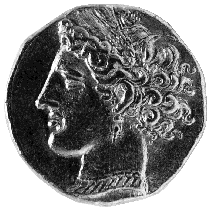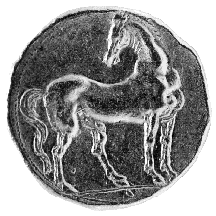



(22) Carthage, Zeugitana (Tunisia) - AV tridrachm, c. 260 B.C.,
12.39 g. (inv. 91.043).
Obverse: Head of Tanit/Demeter/Persephone l., wearing triple-drop
earring, pendant necklace, and crown of grain.
Reverse: Horse standing r. with head turned back.
Provenance: Bank Leu, 1987.
Bibliography: G.K. Jenkins and R.B. Lewis, Carthaginian
Gold and Electrum Coins (London 1963) 391.
The obverse of this tridrachm depicts the chief Carthaginian goddess, Tanit,
or one of the chief Sicilian goddesses, Demeter or Persephone, whose cult
was introduced at Carthage to atone for the Carthaginian destruction of
their temples in the late fifth century B.C. (see no. 21).
The type is based on the Arethusa by Euainetos on Syracusan dekadrachms
(see no. 19) and shares the same general hairstyle,
the thin remnant of Arethusa's reeds at the crown, and the triple-drop earring,
but it also has stalks of grain in its wreath that have encouraged identification
with the agricultural goddesses Demeter and Persephone.
The horse on the reverse probably refers to the foundation legend of Carthage.
According to that story, Juno showed the Phoenicians the future site of
Carthage by indicating where they should dig up a horse's head, which would
be a symbol of their military prowess (Virgil, Aeneid 1.441-44).
K.L.M.



All contents copyright (c) 1996.
Lawrence University
All rights reserved.